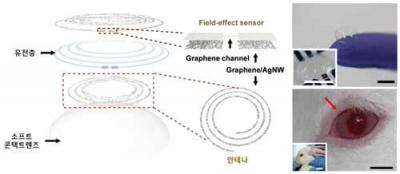Researchers affiliated with UNIST have raised the possibility of in-situ human health monitoring by wearing a contact lens with built-in wireless smart sensors. Towards this end, the team made use of smart contact lens sensors with electrodes made of graphene sheets and metal nanowires.

The smart contact lens sensor could help monitor biomarkers for intraocular pressure (IOP), diabetes mellitus, and other health conditions. The research team expects that this research breakthrough could lead to the development of biosensors capable of detecting and treating various human diseases, and used as a component of next-generation smart contact lens-related electronic devices.
Since blood sugar can be measured with tears, many attempts have been made to monitor diabetes with contact lenses. The biggest drawback with conventional smart contact lenses was thought to be poor wearability; The electrodes in existing ones are opaque, and therefore obscure the view when wearing it. In addition, many complaints of comfort issues arise.
The research team tackled these issues by developing a sensor based on transparent and flexible materials. Their new smart contact lens sensors use electrodes made of highly stretchable and transparent graphene sheets and metal nanowires. Using this sensor, patients with diabetes and glaucoma may one day be able to self-monitor blood glucose levels and eye pressure. Through the embedded wireless antenna in the contact lens sensor, people can also transmit their health information. In addition, because the system uses wireless antenna to read sensor information, no separate power source, like battery is required for the smart contact lens sensors.
Intraocular pressure measurement can be achieved using the dielectric layers. The dielectric layer is an electrically non-conductive layer, characterized by polarity that divides both positive and negative charges. The thickness of this layer changes from thinning as the intraocular pressure increases, to thickening as the intraocular pressure decreases. The IOP sensor, embedded in the contact lenses senses this and transmits the information to the wireless antenna.
According to the research team, their newly-developed smart lenses with built-in pressure-sensing and glucose-monitoring sensors could still detect blood glucose and IOP despite the deformation of the contact lenses. The sensor characteristics were also maintained even when exposed to various substances in human tears. The contact lens sensor characteristics are also not changed when the lens is deformed.
In September 2015, researchers at Swinburne University of Technology, collaborating with Monash University, developed an ultrathin, flat, lightweight graphene oxide optical lens with extraordinary flexibility, that enables potential applications in on-chip nanophotonics and improves the conversion process of solar cells. It might also open up new possibilities in areas like non-invasive 3D biomedical imaging, aerospace photonics, micromachines and more. In February 2017, researchers at Seoul National University, Graphene Square and Interojo have shown that graphene-coated contact lenses could protect eyes from electromagnetic radiation and dehydration and be used in various healthcare and wearable technologies.